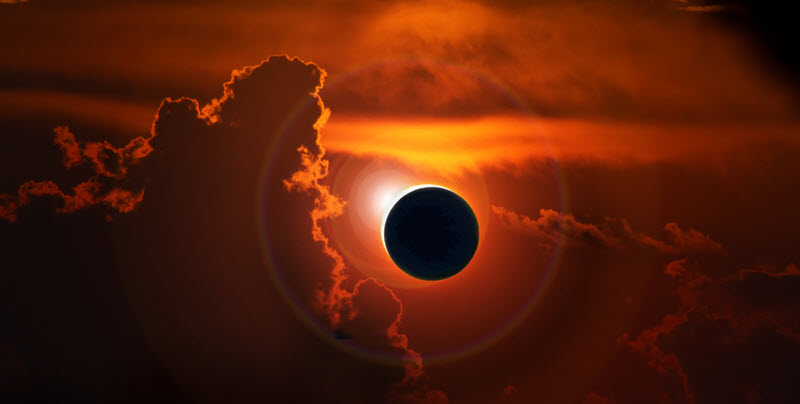| By Gale Staff |
Monday, April 8, 2024, marks a major astronomical event across North America—a total solar eclipse. Those living in its direct path, known as “the path of totality,” will experience over four minutes of night-like darkness. Millions eagerly anticipate this astounding moment, as the next total solar eclipse visible from the U.S. won’t happen again until 2044.
A solar eclipse occurs when the moon passes between the sun and the Earth, momentarily blocking our planet from the sun’s rays and forcing a typical day into a period of shadow. While brief, the eclipse disrupts our planetary systems’ normal ebbs and flows. It’s a moment that causes some people and animals to behave strangely; even scientists can’t fully explain nature’s reaction to the eclipse. It’s a fascinating phenomenon to share with your class, regardless of whether or not you find yourself in the 2024 path of totality.
To help you prepare a stellar lesson, Gale In Context: Science houses a special eclipse-themed portal. This collection examines what causes an eclipse along with intriguing concepts like archeoastronomy, which looks at the relationship between early peoples and the cosmos. Gale’s curated database for K–12 students makes it easy to integrate these topics into a rich classroom discussion for any grade level.
Understand the Basic Science Behind an Eclipse
Why is the upcoming solar eclipse so rare? Several factors must perfectly align for an eclipse to occur—the lunar phase, the distance between the Earth and the sun, and the moon’s orientation (did you know the moon is tilted?).
To explain the basic science, begin with the eclipse summary page in Gale In Context: Science. Students can learn the different aspects of an eclipse, exploring essential terms, a table listing this decade’s schedule of eclipses, NASA’s tips for safe viewing, and the odd ways animals react to sudden total darkness.
There are two distinct categories of eclipses: lunar and solar. During a lunar eclipse, the Earth traverses the path between the sun and the moon, casting a shadow on the latter. Lunar eclipses are slightly more common and last longer. Since the Earth is four times wider than the moon, the shadow it casts is much larger.
In a solar eclipse, the opposite scenario occurs: the moon travels between the Earth and the sun. The path of the moon’s shadow on Earth is only about 300 miles across; individuals must be directly along its trajectory, and the weather needs to be clear enough to experience it.
Several partial versions occur throughout the calendar year, while a total eclipse happens roughly every other year. Witnessing a total solar eclipse is considered especially rare because of the precise factors required to see it. Gale In Context: Science can help you access a range of modeling tips and helpful videos to help your students understand scientific logistics.
Explore the Intersection Between Culture and Science
Besides being a fascinating scientific topic, eclipses played—and continue to play—a vital role in cultural and religious observations.
Encourage your students to imagine what life may have been like before modern astronomical science. Early peoples would witness an otherwise ordinary day inexplicably plunge into darkness. It must have been mysterious and frightening. Some ancient cultures viewed the eclipse as a heavenly message or omen. Many indigenous tribes today maintain their own beliefs surrounding the eclipse. Some, like members of the Navajo Nation, view the eclipse as a symbol of death, treating the event with utmost respect and avoiding watching it entirely.
An eclipse can create a heightened emotional response and often appears in films and stories to symbolize change or to foreshadow a plot twist (such as the famous scene in Little Shop of Horrors). As a result, cities along the 2024 Path of Totality are preparing for a dramatic wave of visitors. Whether seeking to fulfill a scientific or spiritual curiosity, millions will travel to experience just four minutes beneath the moon’s shadow.
Regardless of the scientific explanation, a total solar eclipse can be a powerful and even spiritual experience for people in its path. Use Gale In Context: Science to find more valuable resources that explore the evolution of our scientific understanding, human history, and cultural practice.
Determine Your Exposure to the Path of Totality
The last solar eclipse occurred in 2017, but this year’s event will last longer and impact a wider swath of the United States. Fifteen states (Arkansas, Illinois, Indiana, Kentucky, Maine, Michigan, Missouri, New Hampshire, New York, Ohio, Oklahoma, Pennsylvania, Tennessee, Texas, and Vermont) will witness at least a piece of the cosmic spectacle.
Regardless of where you live along the path, it’s a quick event that requires some planning. Starting around noon (CDT), the 2024 eclipse’s path across the country will begin near southern Texas, arc past Cleveland, Ohio, and exit from northern Maine around 4 p.m. (EDT).
As a class, access great interactive maps to ascertain your town’s position relative to the 2024 path of totality, including its duration and the exact time the eclipse will occur. If your class is lucky enough to experience part of the eclipse during school hours, prepare accordingly.
It’s essential to view the eclipse safely. While an incredible sight, a solar eclipse is unsafe to look upon with unprotected eyes. Onlookers risk serious eye injury, especially using a telescope, binoculars, or a camera. See if your school can invest in simple, readily available eclipse glasses. Or, you can research strategies to make your own solar viewer. For a super simple version, you only need a thumb tack and paper!
Regardless of the grade you teach or proximity to the path of totality, Gale In Context: Science houses reliable content for student curiosity. Our curriculum-aligned resources, individualized learning tools, and user-friendly platform provide an invaluable classroom tool.
If your institution doesn’t currently subscribe to Gale, touch base with a dedicated representative today or request a product trial.



